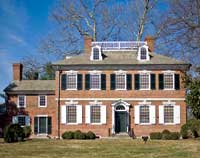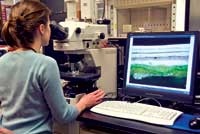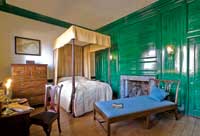
The Corbit-Sharp House, built in 1774, was completely restored in the 1930s. (Photo: Catherine R. Matsen)
Choosing paint colors is usually one of the first projects that new owners of both contemporary and older homes tackle. While for the former, the process may be as simple as strolling into a paint store and picking up a few chips in their favorite colors, the proposition becomes more complicated for owners of historic homes, who often want to determine the original interior and exterior finishes of their houses.
Architectural historians routinely gather this sort of information through paint research—a detailed process that incorporates analysis of existing paint finishes with the study of building documents and structural analysis—to provide them with a better understanding of the home’s inhabitants and the tastes of particular periods, as well as how a building has changed over time. An in-depth look at the paint research process on one Delaware house museum reveals the high-tech equipment and creative solutions required to replicate historic paint finishes.
House Details
The 1774 Corbit-Sharp House in Odessa, Delaware, is an important example of Georgian architecture, recognized for its fine woodwork and related in design to significant contemporary Philadelphia houses. The house also stands as a testament to its commissioner, William Corbit, who earned his fortune as a tanner and, through astute business practices, became a successful figure in the community. The Corbit house underwent alterations throughout the 19th and early 20th centuries but was carefully restored by H. Rodney Sharp in the late 1930s to its original configuration—greatly facilitated by a detailed 1774 bill from builder Robert May, which provided the names of architectural elements, including every item of woodwork in the house. Corbit’s own building account, which presents a construction timeline and suggests material sources, also proved invaluable in the restoration process.
Although two previous paint analyses of the Corbit-Sharp House had been performed (one in the 1940s or ’50s and another in the late 1970s), such dramatic advances have been made in paint analysis methodologies since then that the Historic Odessa Foundation, which owns the house, wanted to conduct another paint study to determine the original finishes of the interior woodwork and plaster. The latest analysis would use high-powered microscopes to more accurately evaluate paint stratigraphies (the build-up of multiple layers of paint) in cross-section. Identifying the pigments, binders, and fillers within stratigraphies can assist in dating paint layers. Interpretation of these findings helps to define 18th-century decor as it relates to the functions and significance of the rooms and the deliberate choices Corbit made in regard to his country mansion.

The author excavates small chunks of paint to study cross-sections under a microscope. (Photo: Steve Pulinka)
Uncovering Original Finishes
Prior to on-site sampling of the finishes, we thoroughly reviewed the carpenter’s account of the Sharp restoration in order to understand the interior alterations. This information guided the locations of sample acquisitions so we could obtain original, first-generation finishes. Paint samples, approximately 1⁄8″ in size, were carefully taken with a small scalpel to keep the wood or plaster substrates intact. These samples were then encased in polyester resin, which was allowed to harden. We cut the cubes to expose the paint cross-sections and hand-polished them with high-grit polishing cloths to achieve a smooth, glassy surface. Finally, the cross-section samples were examined and photographed under visible and ultraviolet light at 125x to 250x magnification so we could assess the layered structure of the multiple paint generations.
After thorough analysis, we determined that the original finish of the rear first-floor chamber was a copper resinate glaze made from green verdigris pigment. The glaze would have conferred a vibrant, translucent green finish that would have glowed like an emerald in the candlelight. Verdigris-based treatments were very popular during the 18th century and have been found in other gentry houses of the period, such as George Washington’s Mount Vernon, Thomas Jefferson’s Monticello, and George Mason’s Gunston Hall. The copper resinate glaze is a markedly different finish from the other rooms of the house, which were originally a stone or cream color made with lead white and iron ochre pigments with chalk in a drying oil (likely linseed) medium.

Analyzing the paint cross-section with a high-powered microscope reveals in-depth information about the paint layers added to the room throughout the years. (Photo: Jim Schneck)
Finding a Match
After we identified the first-generation paints in the Corbit-Sharp House, we took numerical color measurements of the original paint layers with a colorimeter microscope. This helped restorers match original paint colors with modern paints.
Color matches are useful in understanding historical color palettes, but they provide only one component of the visual quality of historic paints. Modern paint formulations can’t replicate the gloss and texture of original paints, so ideally, period methods and materials should be used to reproduce hand-ground paints.
In the Corbit-Sharp House, though, re-creating the original green glaze in the first-floor rear chamber required some creative solutions. Restoring the glaze using copper resinate and verdigris would have been prohibitively expensive, and matching the color to a single finish wasn’t possible due to the translucent nature of the glaze. So the restoration team mocked up various combinations of modern commercial products on sample boards and visually compared them in order to find the one that best matched the appearance of the original.
Meanwhile, because the original finish had darkened so much over time under later paint layers, they made a smaller mock-up with pure copper resinate to simulate the original appearance of the finish.
In the end, a four-layered technique—consisting of two gray primer coats, a green semi-gloss paint cut with liquid glazing, and a final polyacrylic clear finish—was used to re-create the original glaze. In preparation for painting, the woodwork and plaster were scraped just enough to remove loosely adhered, flaking paint. This was done in order to retain as much of the full paint history as possible for future study and re-analysis. Photographs of the recently re-created verdigris finish in the small dining room at Mount Vernon helped second-generation painter Rob Galloway establish proper brushing techniques. (Paintbrushes in the 18th century were round and usually made of hog’s hair, resulting in a slightly textured and streaky finish.)

The green glaze was re-created with a four-layer application of modern finishes. (Photo: Catherine R. Matsen)
Context Clues
The unique treatment of the first-floor rear chamber clearly distinguishes this space from the other rooms in the house. At the time, this was a costly finish, not only due to the expense of verdigris, but also because the preparation and application of the copper resinate glaze would have required the skill of an experienced painter. This treatment was a deliberate demonstration of Corbit’s wealth and taste, particularly in what was, architecturally speaking, a secondary space.
However, the choice of paint finishes is only one facet of the overall decoration in a given room. The finish treatments must have been intimately linked with all the other room furnishings and level of architectural detail. But the choice of this decorative architectural finish provides key insights into William Corbit’s personal aesthetic and represents decisions made with keen awareness of social and cultural implications. Thus, architectural paint analysis not only determines the original colors of historic paints, but also contributes to the architectural and socioeconomic interpretation of historic buildings.
At-Home Research
For years, paint research has been done via scrape tests—methodically scraping away paint in an attempt to expose every layer applied. But scrape tests can present a host of errors—for example, it can be difficult to distinguish between successive layers of similarly colored paint, especially with off-white paints. It’s also easy to miss subtle features, such as varnishes applied to topcoats of paint, as they aren’t readily discernable to the naked eye. And it’s not uncommon to mistakenly identify primer or ground coats as final finish coats of paint. Visible light alone can’t always highlight distinctions between multiple paint and varnish layers—it often takes ultraviolet illumination to make inorganic materials apparent. This is why professional researchers examine paint cross-sections with a high-powered reflected visible and ultraviolet light microscope.
The majority of homeowners have neither access to high-powered microscopes nor the means to hire a professional paint analyst, but you can adjust this procedure to obtain general information. Make a small excavation in the paint, and examine the layers in situ using a small pocket microscope at 30x to 100x magnification. This will reveal greater distinction between the multiple paint layers; the earliest topcoat layer can then be visually compared to commercial paint swatches. While this at-home technique won’t provide a match that’s 100-percent accurate, it can be helpful in uncovering basic information on a home’s original finishes.
Catherine R. Matsen is an associate scientist at Winterthur Museum’s Scientific Research and Analysis Laboratory.
Online exclusive: Consult our guide to period-appropriate paint colors and formulas.







